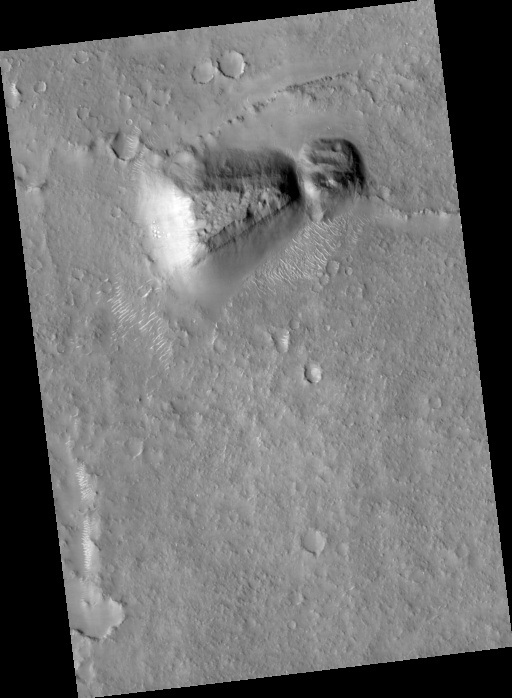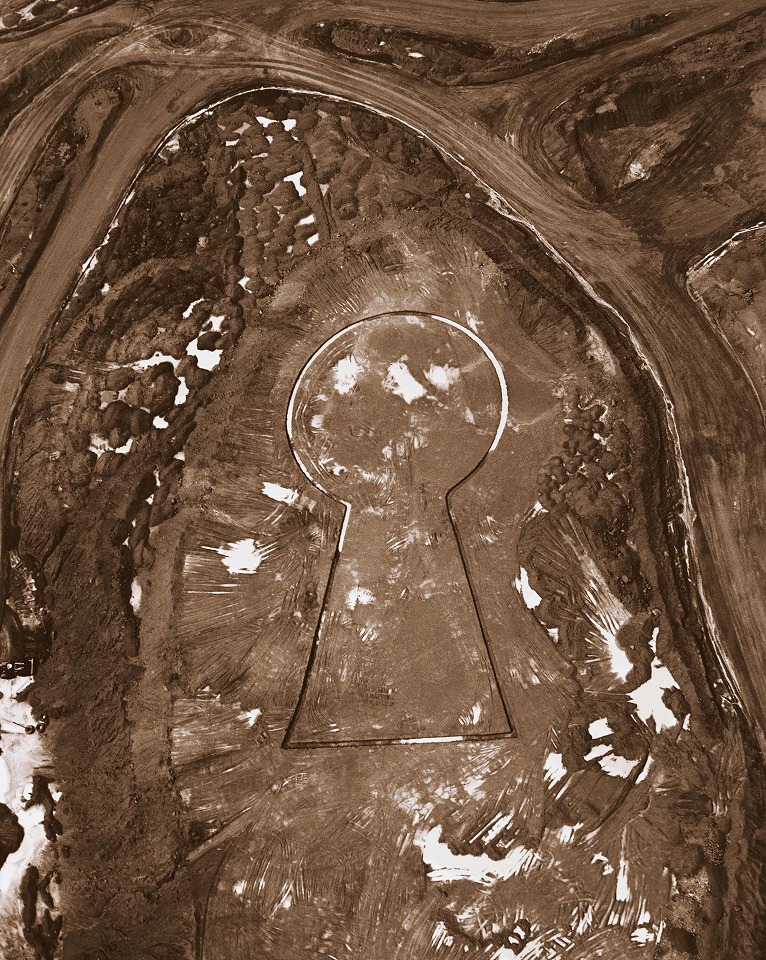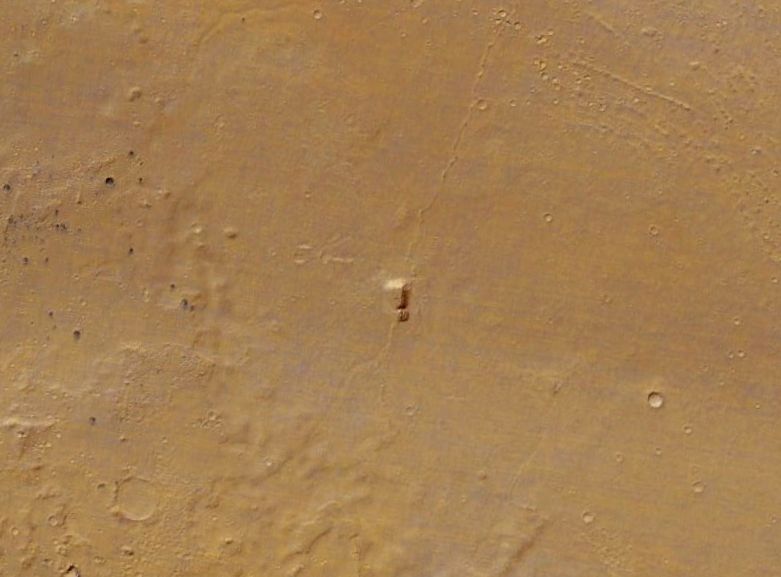|
|
Post by George J. Haas on Jul 17, 2013 12:24:59 GMT -5
Here is a MRO HiRISE image (ESP_020794_1860) of a large geometric structure on Mars. The massive structure appears isolated on a flat empty plane. Notice the symmetry of the structure. The sides of the structure appear to have straight edges that run down to a large circular "dot" formation at its base...the wedge and dome (keyhole) formation suggested an exclamation mark design to one of the NASA scientist.  If you can't see it...turn this image sideways (so North is to the right) NASA says the straight edges may be the result of fractures, related to faults or a hill that was lifted up by the faulting and its current shape was the result of the surrounding terrain having been eroded down over billions of years... Image source: www.uahirise.org/ESP_020794_1860GJH |
|
|
|
Post by George J. Haas on Jul 18, 2013 9:15:55 GMT -5
Here is an example of a terrestrial geoglyph in the shape of an exclamation mark.  The Land Art formation was created in Sun City California. Note the bar form is not symmetrical (a little bent on one side) and the "dot" is not round... GJH |
|
|
|
Post by starjim on Jul 18, 2013 17:27:04 GMT -5
Just wondering if the material around the long part of the feature has accumulated around it or if like features in Ariz, Texas and similar areas where mountains have been eroded away to have a mesa sticking up with the soft material draped around it at the bottom?
|
|
|
|
Post by George J. Haas on Jul 23, 2013 6:41:24 GMT -5
Here is a view of the exclamation mark, or wedge and dome-shaped formation when rotated 90 °.  Note, despite extensive erosion over the structure, the formation exhibits remarkable symmetry. GJH |
|
|
|
Post by George J. Haas on Jul 23, 2013 6:55:36 GMT -5
If a demarcation line (labeled i ) is placed above the ridge line between points, a and c, of the wedge formation and brought to extend down through the base of the dome formation - ending at J, the symmetry of the formation becomes noteworthy.  Looking at the parallel sides of the wedge-shaped formation, they appear as straight ridges that run down to a truncated base at an angle of 30 degrees... on both sides (Note points a-b and c-d). The lower ridge line extending from point a to point b are parallel to the upper ridge line that extends from point e to point d. The adjoining upper ridge line, extending from point f to point h is parallel with the lower ridge line extending from c to point d. The large dome-shaped formation, located directly below the wedge-shaped formation appears to be a partially collapsed, circular dome. Notice the crevice across the center. The big question is - how do you explain the formation of these two opposing formations? How could wind or water erosion create the wedge shaped formation, moving along the sides of the wedge form from point a to b - without destroying the dome-shaped formation adjoining it? GJH |
|
|
|
Post by George J. Haas on Jul 26, 2013 9:13:33 GMT -5
Terrestrial analogue to the Wedge and Dome-shaped (Exclamation Mark) formation on Mars has been found in Kofun Japan!  Note the common wedge and dome "keyhole" design of this Japanese tomb - which was built around 250 – 538AD. Hummm. GJH |
|
|
|
Post by George J. Haas on Jul 28, 2013 7:33:44 GMT -5
Here is another example of a terrestrial wedge and dome- keyhole shaped tomb, this one found in the Bayuda region of the Sudan. GJH Attachments:
|
|
|
|
Post by marsevidence01 on Jul 30, 2013 23:06:57 GMT -5
Hello George, I thought I'd stop by and introduce myself as I have been following your work for some time and in particular, your focus in the arena of Meso America. I can add that I have been researching the many anomalies on Mars for several years and I have seen many similarities to this past culture expecially in there many facial constructions and designs.
I have been placing quite a bit of my work over at Meta Research but as you are no doubt aware, there dosen't seem to be too much interest in Martian anomalies on this site. It's a shem really but here you are.
Hope to hear from you when you have some time.
Thanks
Malcolm
|
|
|
|
Post by George J. Haas on Aug 1, 2013 8:43:33 GMT -5
This Youtube Video PLAGIARIZES THE WORK OF THE CYDONIA INSTITUTE !
Please visit the youtube page and demand that the producers of this program revise their video and credit The Cydonia Institute for all of our work used in this video - including text, images and the graphic drawing of the wedge and dome-like formation.
GJH
|
|
|
|
Post by ufovni on Aug 1, 2013 12:50:51 GMT -5
|
|
|
|
Post by George J. Haas on Aug 5, 2013 6:56:44 GMT -5
Here is a Keyhole geoglyph produced by Brazilian Land Artists Vik Muniz, on land owned by the Carajás Mining Complex.  GJH |
|
|
|
Post by billsaunders on Aug 6, 2013 18:07:26 GMT -5
The main question here is "how do erosional forces round the edges and the surface of the 'dot' and not the rectilinear section?" The answer is, it didn't. Given their isolated location it is highly unlikely they are composed of different material. Some other oddities are the four different directions of what appears to be duning (indicated by the red arrows) without any swirling. As well there is no duning on the apparently loose detritus or talus material on the side of the structure. Another oddity is the pitting shown within the red squares. The obvious symmetry of this structure goes against natural forces. Symmetry in nature is found in biological systems whereas inanimate objects exposed to environmental forces tend towards randomness and abstraction. Attachments:
|
|
|
|
Post by marsrocks on Aug 15, 2013 21:29:25 GMT -5
|
|
|
|
Post by George J. Haas on Aug 20, 2013 9:56:17 GMT -5
Thanks to Google, here is a look at the overall structural isolation of the Wedge and Dome formation.  It's really out in the middle of nowhere. GJH |
|
|
|
Post by billsaunders on Aug 28, 2013 12:40:44 GMT -5
See what happens when you invert the image. I can see many possible half images as well, however I don't think the lighting and camera angles are quite right. I also think there was some air brushing going on by someone. I also see the potential for some bird-like images with the shape of the "so-called dunes". Attachments:
|
|